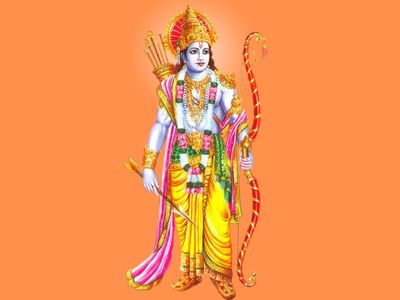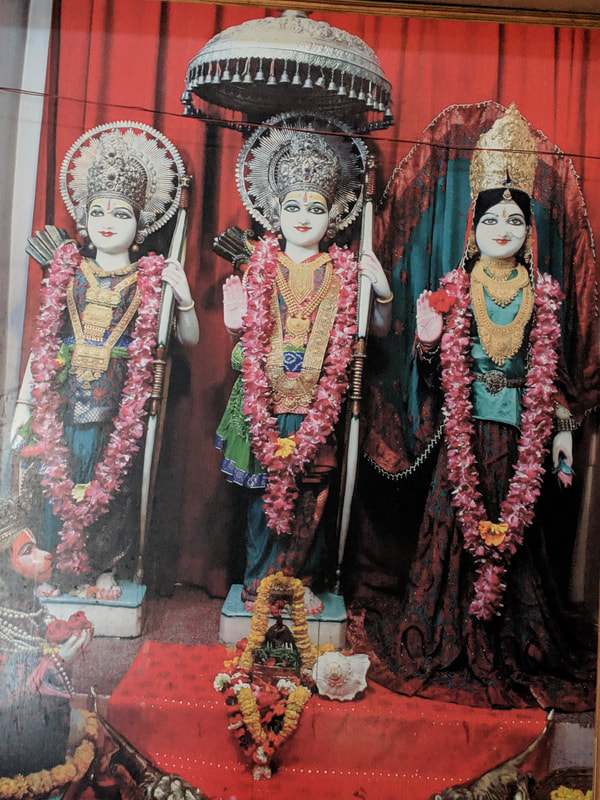|
Sri Rama, the Historical Being
Sri Rama, the incarnation (Avatar) of the Supreme Protector, Sri Vishnu, is widely worshipped all over India and South & South East & East Asia (Philippines, Thailand, Laos, Mongolia, Siberia, Malaysia, Burma, Indonesia, Java, Sumatra, Cambodia, China, Japan, Lanka and Vietnam). The article aims to highlight that Sri Rama, the historical being. Further, it deals with the questions such as, Whether Sri Rama Born; When Sri Rama Born. Whether Sri Rama Born: Many people create controversies on the birth of Sri Rama. Bhagwan Sri Rama Chandra was born in human form on the ninth day of the lunar month Chaitra as per Hindu calendar (March–April) in Ayodhya (UP) at the end of the second Age or Treta-yuga. The fact has been proved in Supreme Court in its judgement dated 9th November, 2019 of Ramjanmabhomi case; based on scriptures (including 'Valmiki Ramayana' and 'Skanda Purana') and archeological excavations. There are numerous places that are indicated as the locations where various events happened in the life of Sri Rama detailed in Ramayana. These locations are now historical sites such as Chitrakoot, Bhadrachalam, Ramesvaram, Nasik, Hampi, Pampa, Sabrimala, Janakpur in Nepal, several caves, such as Ravana Ella Falls in Sri Lanka and others. When Sri Rama Born: As per the Institute for Scientific Research on Vedas (I-SERVE), planetarium software has ascertained the birth of Lord Rama as 10th January 5114 BC in Ayodhya based on the details available in Valmiki Ramayana. However, as per Vayu purana (70/48) shloka – “।।त्रैतायुगे चतुर्विर्श रावणस्तपसः क्षयात्।। ।।रामं दाशरथिं प्राप्य सगणः क्षयमीयवानम्।।“ Means:-for the behavior of Ravna & due to his bad deeds he was killed in battle by Dashrath Nandan Rama in battle of sri lanka, in 24th stage of treta yuga. If we go by Vayu purana, Sri Rama was borne in last part 24th stage (Manvantar) of trata yuga. As per Vedic calculations, each Manvantar is further divided into chaturyugis. Each chaturyugis consist of satyuga, traita, dwapar and kaliyuga having 4,800 Deva Vatsaras, 3,600 Deva Vatsaras, 2,400 Deva Vatsaras and 1,200 Deva Vatsaras (summing up to 12000) respectively. Deva Vatsara means one day and one night of God i.e. equal to one human year of 360 days approx. Hence, one chaturyugi is 12,000 * 360 = 4320,000 human years. This is the 28th chaturyugi and first charan(period) of this chaturyugi is in continuation. Hence, the period, since Sri Rama till now comes to around 1.75 to 1.80 million years back. According to astronomy, the positions of zodiac constellations come back to their original place after a cycle of approximately 26,000 years. The scientific interpretation of the photographs of the remains of Adam's Bridge (Ram Setu) taken by NASA's Gemini-11 spacecraft in 2002, reveals that this ancient bridge linking India to Sri Lanka was manmade, and it was dated to be at least 1.75 million years old. When Worship of Sri Rama heightened: Since thousands of years Sri Rama’s character has been inspiring millions of people. Ramananda (Born in Prayagraj UP and settled in Varanasi, lived in 1300-1411 century), placed devotional focus upon Rama, whom he considered supreme Lord. He was the spiritual Guru of the twelve great leaders of Vaisnava cult in North India. Among the group's most prominent members were Tulsidas, Kabir (Muslim), Mirabai, Ravidas (cobbler by birth), Sena (barber by caste), Dana (jat), Pipa (Rajput), Dadu and others. It is widely known that Sant Tulsidas has met Bhagwan Rama through Bhakt Hanuman as a reward of composing Sri Ramcharitramanas.
0 Comments
Sri Rama, the Almighty
Sri Rama is the most popular symbol of magnanimity and virtue. Swami Vivekananda mentioned that Sri Rama is "the embodiment of truth, of morality, the ideal son, the ideal husband, and above all, the ideal king." He is seen as an embodiment of perfection. He led by example. It is said, “Name of Rama is bigger than Rama himself”. The fact lies in the word "Rama" which is made up of two spores (bijakshara), "Agni Beej" and "Amrit Beej". These letters provide strength to the mind, body and soul. The article aims to highlight, whether Sri was Purna Avatara (Incarnation); When Worship of Sri Rama heightened; Why Sri Rama called as Maryada Purushottam; Whether Sri Rama was a Man of Modern Management etc. Whether Sri Rama was Purna Avatara (Incarnation): He was incarnation of Sri Vishnu Bhagwan. Narad ji has described sixty four virtues of Sri Rama to Valmiki ji in Bal kand. A few virtues are one who controls his mind, most powerful, most brilliant, most tolerant, with control over senses, intelligent, virtuous, orator, knower of Dharma, protector of living, and one who is truthful in his resolutions. He displayed unequaled qualities labeled as noble, generous, ethical, fearless, simple, respectful to others etc. He never lied. Some people say he was not Purna Avatar but Maryada Purushottam Bhagwan Rama. Sri Nimbarkacharya, the exponent of Dvaitadvaita philosophy who lived during 12–13th century, sub-divided the incarnations into two categories viz. Amsarupavataras (Matsya, Kurma, Varaha, Vamna etc.), when He manifests them only partially and Purnavataras (Sri Narsimha, Sri Rama and Sri Krishna) when all the qualities & powers of God are manifested. But Sri Madhvaharya, the exponent of Dvaita philosophy who lived during 1238-1317, holds that there is no difference between these incarnations. They are all His Svarupamasas or expression of His entire nature. Why Sri Rama called as Maryada Purushottam: Sri Rama was born in human form and experienced, what an ordinary human being undergo during his lifetime i.e. the pleasures and pains. He is labeled as Maryada Purushottam. Maryada Purushottam is a Sanskrit phrase in which "Maryada" translates to "honor and righteousness", and "Purushottam" translates to "the supreme man". He never transgressed the human and social life. He lived always in Maryada (limitation) such as kept the vow of one wife, stick to what he has said. His life reflects an ideal way of living as a student, a householder, a king, a father, a son, a husband, a disciple. He always followed orders of parents, Guru and saints.
Whether Sri Rama was a Man of Modern Management, Yes: Modern Management has provided “SWOT Analysis” as a tool for strategic planning of organizations or situations. SWOT stands for Strengths, Weaknesses, Opportunities, and Threats. Strengths and weaknesses are internal over which one has some control and opportunities and threats are external over which one has little or no control. Strengths and opportunities are favorable and weaknesses and threats unfavorable. The life story of Sri Rama is living lesson for one and all, how he turned weaknesses into strengths and threats into opportunities. Turn Weaknesses into Strength – For a leader, “leading by Example” is best way to set the tone for others. In absence of resources during 14 years exile, he displayed leadership qualities as under:
Turned Threat into Opportunities
|
Archives
May 2024
Categories |


 RSS Feed
RSS Feed